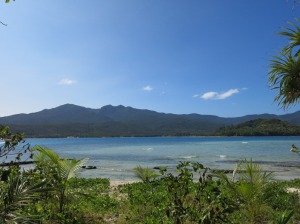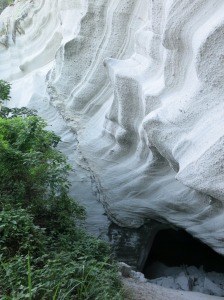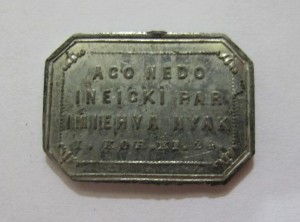In September I ran a Knowledge Exchange workshop as part of National Museums Scotland’s national programme. The workshop ‘An Introduction to Pacific Collections’ was aimed at other museum and heritage professionals in Scotland who care for Pacific collections. This event was one of the outcomes of our Pacific collections in Scottish Museums project. It was an opportunity to share the knowledge I have been developing since beginning the project in April 2013. The event was a one day workshop where attendees could learn about identifying, caring for, displaying and interpreting Pacific material culture.
We began the workshop with an overview of the project, followed by an introduction to the type of material and the cultural areas likely to be found represented in Scottish collections. This information was based on trends which became apparent in the course of reviewing the four project partner collections although of course there will always be surprising artefacts hidden in collections too. I then took everyone around the Facing the Sea Gallery at National Museums Scotland. For any readers who haven’t had a chance to visit the museum, this gallery provides an insight into Pacific culture through display of artefacts from across the region. I talked through different subjects ranging from the concept of mana, the reasons for making and collecting boat models, and changing ideas about how Kiribati coconut fibre armour was be worn.
I took the opportunity to pause at one of my favourite parts of the gallery – a display of fishhooks from all over the Pacific which is great for showing the types of materials used, the variety of distinct styles and the workmanship that went into them. I had also brought some handling materials along for everyone to study and think about styles and materials. We wrapped up the morning with a discussion about collections care, hazards, and considerations when working with secret or sacred material. We discussed cultural considerations in more depth through a case study in which I invited everyone to imagine they had a mask in their collections that was men’s business and that women could not look at or touch. I asked how everyone would approach such an item if it needed to be moved and only a female member of collections staff was available.
After lunch we got into groups to discuss some artefacts which I had invited everyone to bring with them. We had fun trying to figure out where some unprovenanced items in the collection from the Falconer Museum in Forres, near Aberdeen, were from (only one was Pacific!) This was an opportunity to explore what great collections other Scottish museums and archives have.
I had then planned an activity to get people thinking about tourist pieces, authenticity and the way items were made for trade. I wanted to show how you might differentiate artefacts as ‘authentic’ but also encourage everyone to think about the notion of authenticity. There are often interesting stories to be told about trade pieces or items that incorporate designs or materials from outside the local community. It can be easy to forget that trade items for a European market were being made right from the point of contact as communities, as you would expect, took the opportunity to engage in exchange transactions. I had taken three hei tiki pendants from the museum stores – one a beautifully carved early example from the late 18th century, another a well made but possibly for trade item from the early 20th century, and the third a plastic version bought in the 1990s. I had also brought along two flesh forks, often called cannibal forks, from Fiji. These were both rather oversized unused items – one late 19th century bought by Constance Gordon Cumming and the other a roughly made piece from the mid-20th century.
The final part of the day involved a presentation from Pat Allan, project partner and Curator of World Cultures at Glasgow Museums. I invited Pat to speak about working with communities and I ended the session with a film of Marshallese poet and writer Kathy Jetnil-Kijiner reading her moving poem ‘Tell them’. I have shared the link previously and you can find that video here on Kathy’s blog. I wanted to illustrate the contemporary stories which we can tell through our collections such as the massive impact of climate change. It can be easy for museums with 19th century collections to focus on the past but it is important to acknowledge the contemporary nature of every culture.
The knowledge exchange workshop has been developed into a resource entitled Introduction to Pacific collections. This is one of the core outcomes from the Pacific Collections in Scottish Museums project and will be available online from the 25th November 2014 at www.nms.ac.uk/pacific
– Eve














































